


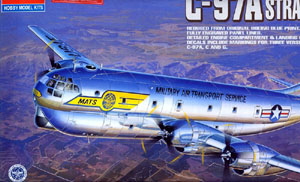 Academy's
1/72 Boeing
Academy's
1/72 Boeing
C-97A Stratofreighter
By Michael Benolkin
Background
In 1942, Boeing began design work for a military transport variant of the B-29 that was already under development (started in 1940). This program was developed using the experience gained from adapting an earlier Boeing bomber, the B-17 into the Model 307 transport. The war had ended by the time the C-97 (and civilian Model 377) series had come off the drawing board. Even so, production of the B-29 had been terminated in favor of the B-50, which incorporated a larger tail, more powerful engines, and a variety of improvements gained from operating the B-29. While the first few YC-97 prototypes were based on the B-29 airframe, the remaining prototypes and production aircraft were derived from the B-50 series.
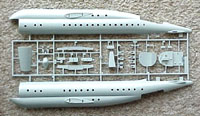 As
a sidebar, the Pratt & Whitney R-4360 engines that powered the C-97
had 27 cylinders per engine generating 3,500 horsepower. In comparison,
the T56 turboprop engine that powered the early C-130A Hercules generated
4,250 shaft horsepower. Unlike the T56, the R-4360 required that the spark
plugs be kept in adjustment to ensure smooth, reliable performance. Since
aircraft engines are equipped with two spark plugs per cylinder (dual
ignition for safety), that meant that each aircraft had 216 spark plugs
to be pulled and adjusted. Ouch!
As
a sidebar, the Pratt & Whitney R-4360 engines that powered the C-97
had 27 cylinders per engine generating 3,500 horsepower. In comparison,
the T56 turboprop engine that powered the early C-130A Hercules generated
4,250 shaft horsepower. Unlike the T56, the R-4360 required that the spark
plugs be kept in adjustment to ensure smooth, reliable performance. Since
aircraft engines are equipped with two spark plugs per cylinder (dual
ignition for safety), that meant that each aircraft had 216 spark plugs
to be pulled and adjusted. Ouch!
The Kit
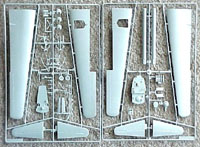 This
is the second installment of this kit from Academy. As you’ll recall,
the first was the Boeing
Model 377 in Pan American colors, which was very warmly received by
the modeling community. The C-97 is Academy’s first military version to
be released, with part three (and final) being the KC-97 tanker.
This
is the second installment of this kit from Academy. As you’ll recall,
the first was the Boeing
Model 377 in Pan American colors, which was very warmly received by
the modeling community. The C-97 is Academy’s first military version to
be released, with part three (and final) being the KC-97 tanker.
The parts trees in this kit are identical to the previous release, as the significant detail differences between the Model 377 and C-97 were included in the first kit. As with the first release from Academy, the fit of the parts in this kit are very nice. If you read last month’s article from Bucky Sheftall on bare metal finishing, you’ll find that the shape and curves of this kit will lend themselves to using that technique!
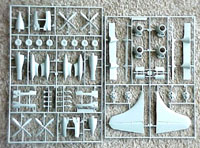 Also
in common with the first kit, you’d better plan on some serious ballast
to keep this bird from becoming a dedicated tail sitter. The instructions
indicate in Step 4 that 60-70 grams will be required, but that might be
a bit too little. I might double that mass in my example.
Also
in common with the first kit, you’d better plan on some serious ballast
to keep this bird from becoming a dedicated tail sitter. The instructions
indicate in Step 4 that 60-70 grams will be required, but that might be
a bit too little. I might double that mass in my example.
As with other recent generation large kits, Academy has provided wing spars to help hold this kit together. Given the sheer size and weight of the aircraft, you’ll probably want to use something like Testors Liquid Cement to get the best bond/greatest strength out of the major fuselage/wing assemblies.
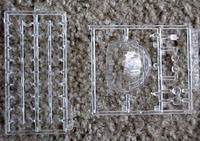 The
kit provides the wing flaps as separate parts, though they are intended
to be installed in the up position. Nonetheless, this will make it a little
easier for the detailer to pose the aircraft in takeoff or landing configuration.
The
kit provides the wing flaps as separate parts, though they are intended
to be installed in the up position. Nonetheless, this will make it a little
easier for the detailer to pose the aircraft in takeoff or landing configuration.
The major difference between this kit and its civilian counterpart is the beautiful markings that were applied to the early Military Air Transport Service aircraft. Markings are included for C-97A 48-399 that flew in the Pacific Division of MATS (the boxart aircraft), C-97C 50-700 of MATS (adorned with fluorescent orange bands), and C-97G 53-245 of the 115 Air Transport Squadron, California Air National Guard.
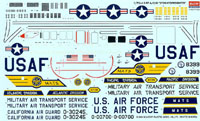 This
kit is a very welcome addition to a much-overlooked area in scale aviation
modeling – airlift. While we have had KC-135s, C-130s, C-121s, and even
a C-7 available in 1/72 scale, the C-97 was one of many airlift workhorses
that have gone unrepresented in this scale on our shelves, that is until
now. Way to go Academy! My sincere thanks to MRC
for this review sample!
This
kit is a very welcome addition to a much-overlooked area in scale aviation
modeling – airlift. While we have had KC-135s, C-130s, C-121s, and even
a C-7 available in 1/72 scale, the C-97 was one of many airlift workhorses
that have gone unrepresented in this scale on our shelves, that is until
now. Way to go Academy! My sincere thanks to MRC
for this review sample!

Previous: Contents







